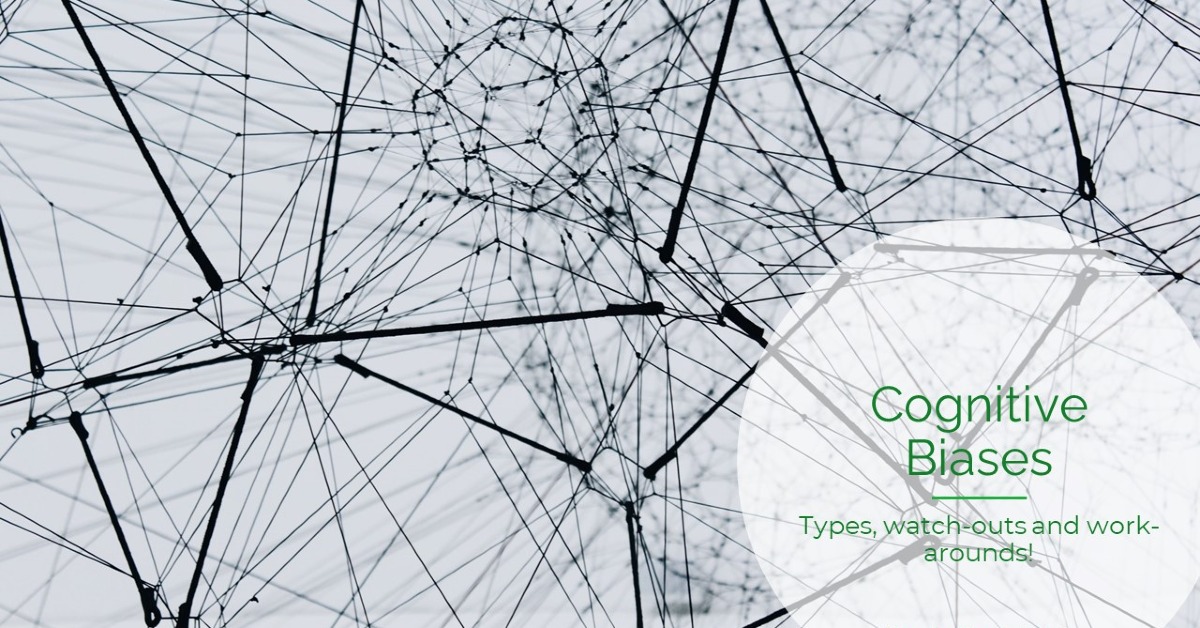Cognitive Biases Primer
Types, watch-outs and work-arounds!
With their origins in the hunter-gatherer evolution of humans, cognitive biases are deeply rooted into our neuroscience. These are mental shortcuts (known as heuristics), that help us make sense of the vast information around us. Without them, we will be crippled when it comes to fast decision making and survival.
So there’s nothing wrong with having unconscious bias, right?
Not entirely!
-
Unconscious bias is great for survival and ‘fast’ decision making, as Daniel Kahneman would put it - System 1 Thinking (Thinking, Fast and Slow – 2013).
-
However, ‘slow’ and deliberate thinking (System 2 Thinking) requires us to remove these filters
Good news is – it’s possible to work-around these biases once you are aware how to spot them. Let’s look at the top 10 biases that can cloud your decision making at a workplace and how to work around them.
10 Types of Cognitive Bias:
- Likeability Bias
- Affinity Bias
- Attribution Bias
- Confirmation Bias
- Halo (or Horns) Effect
- Proximity Bias
- Bandwagon Bias
- Loss Aversion
- Anchoring Bias
- Availability Heuristic
 Photo by Kelly Sikkema on Unsplash
Photo by Kelly Sikkema on Unsplash
Likeability Bias
Rooted in how we expect people of certain groups to behave, this bias leads us to liking people who behave as per these expectations. For example, men are liked when they are assertive, women when they are gentle and so on.
- A woman may assert her ideas and face ‘likeability penalty’, getting her ideas shot down.
- A young intern is not liked for questioning established processes and suggesting new ones
- Separate the person from the idea
- Institute standard, competency-based processes for evaluation of ideas and performance, regardless of who is assessing or being assessed
Manifestations at work
Work Around
 Photo by Rachael Gorjestani on Unsplash
Photo by Rachael Gorjestani on Unsplash
Affinity Bias
Our tendency to gravitate towards people like ourselves in appearance, beliefs, and background. Flip side, we may avoid or even dislike people different from us.
- The classic ‘culture fit’ hiring – we are unconsciously falling for someone who reminds us of ourselves
- Actively take note of the similarities you share with another person so that you can differentiate between attributes that may cloud your judgement
- Start talking about ‘culture adds’ rather than ‘culture fits’
Manifestations at work
Work Around
 Photo by Ben Sweet on Unsplash
Photo by Ben Sweet on Unsplash
Attribution Bias
Attribution bias is a phenomenon where you try to make sense of or judge a person’s behavior based on prior observations and interactions you’ve had with that group represented by the individual.
- Women are considered less competent at certain domains like STEM
- People from vernacular backgrounds are assumed to have challenges with English speaking skills
- Don’t assume. Ask.
- Hear the full story of the person and treat them as unique
Manifestations at work
Work Around
 Photo by Tolga Ahmetler on Unsplash
Photo by Tolga Ahmetler on Unsplash
Confirmation Bias
Our tendency to favour information that confirms our pre-existing beliefs. This occurs when we have decided a course of action and look for evidence to prove it correct!
- Based on the resume, the hiring decision is made up and the interview is used to prove that decision right.
- A new worker is judged a certain way and all interactions with the team make the judgment come true.
- Competency based hiring or using structured/ standardised interviews.
- Introduce a robust onboarding processes.
Manifestations at work
Work Around
 Photo by Adrian Smith on Unsplash
Photo by Adrian Smith on Unsplash
Halo (or Horns) Effect
The tendency to judge others similarly on all traits. The assumption that because someone is good or bad at one thing, they will be equally good or bad at another.
- Candidates from a certain education background are treated highly or poorly.
- A person who is often late to work is overlooked for promotions despite overachieving targets.
- Introduce multiple rounds of interviewing in the hiring process, when different people view the candidates.
- Set clear expectations.
- Hear the person.
Manifestations at work
Work Around
 Photo by Tolga Ulkan on Unsplash
Photo by Tolga Ulkan on Unsplash
Proximity Bias
People who work in close proximity have a larger impact on our thinking and decision making than those away.
- Candidates interviewed in person are viewed more favorably than those interviewed via distance technology.
- Remote team members receive a less favourable performance feedback.
- Level the playing field. Use the same method of communication when conducting team meetings.
- Use standardised/ competency-based processes.
Manifestations at work
Work Around
 Photo by Edwin Andrade on Unsplash
Photo by Edwin Andrade on Unsplash
Bandwagon Bias
A common bias favouring ideas adopted by others. It could take the shape of Conformity bias – acting similar to people around, regardless of own beliefs – or Authority bias – when linked to an influential person’s beliefs.
- Ideas suggested by the team leader or majority are voted up.
- Gain everyone’s personal perspective separately first (either through a silent, written brainstorm or through one-on-one conversations) before opening it to the team for review and discussion.
Manifestations at work
Work Around
 Photo by Charles Deluvio on Unsplash
Photo by Charles Deluvio on Unsplash
Loss Aversion
Preferring the choice that has been decided upon rather than looking for more and better options. Choosing low-risk certainty over high-risk potential.
- “This is how it’s been done”
- “This solution worked the last time”
- “Thou shalt not fall in love with thy solutions”
- Put away the tried and tested or low-risk solutions and brainstorm new ones. If you still revert to the tried and tested ones, you still got a few more ideas for next time!
Manifestations at work
Work Around
 Photo by Darinka Kievskaya on Unsplash
Photo by Darinka Kievskaya on Unsplash
Anchoring Bias
Being influenced by the first piece of information obtained and using it as the baseline for comparison.
- Expecting a new management trainee to behave the same way as you did when you joined your first job!
- Rejecting all CVs because you have ‘anchored’ your expectations with the incumbent of the role
- Slow down and ask for more time, where possible.
- Jot down what’s similar and what’s different in your experience and your ‘anchor’. Be conscious of these when taking decisions.
Manifestations at work
Work Around
 Photo by Zachary Spears on Unsplash
Photo by Zachary Spears on Unsplash
Availability Heuristic
Taking decisions based on the first information that comes to mind because we believe that it must be significant, hence we remembered it.
- “Remember the person from Chennai who couldn’t adjust to Delhi weather. Let’s look at regional candidates only please.”
- Selectively bringing information into a performance feedback session.
- Blind the resumes. Mask information that may cause biases to creep in at a screening stage.
- Institute an ongoing process of feedback or at least document evidence (like a performance journal).


